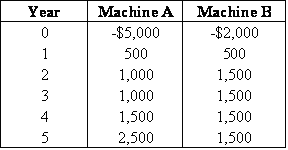CFA Level 1 - Corporate Finance
Payback period (PP) is the number of years it takes for a company to recover its original investment in a project, when net cash flow equals zero. In the calculation of the payback period, the cash flows of the project must first be estimated. The payback period is then a simple calculation.
Formula 11.10
PP = years full recovery + unrecovered cost at beginning of last year cash flow in last year |
The shorter the payback period of a project, the more attractive the project will be to management. In addition, management typically establishes a maximum payback period that a potential project must meet. When two projects are compared, the project that meets the maximum payback period and has the shortest payback period is the project to be accepted. It is a simplistic measure, not taking into account the time value of money, but it is a good measure of a project's riskiness
| Look Out! For payback periods, the decision rules are as follows: If payback period < the minimum payback, accept the project If payback period > the minimum payback, reject the project |
Example: Payback Period
Assume Newco is deciding between two machines (Machine A and Machine B) in order to add capacity to its existing plant. The company estimates the cash flows for each machine to be as follows:
Figure 11.2: Expected after-tax cash flows for the new machines
Calculate the payback period of the two machines using the above cash flows and decide which new machine Newco should accept. Assume the maximum payback period the company establishes is five years.
Answer:
First it would be helpful to determine cumulative cash flow for the machine project. This is done in the following table:
Figure 11.3: Cumulative cash flows for Machine A and Machine B
Payback period for Machine
A = 4 + 1,000/ 1,500== 4.67
Payback period for Machine
B = 2 + 0 = 2.00
0
Both machines meet the company's maximum payback period. Machine B, however, has the shortest payback period and is the project Newco should accept
2. Discounted Payback Period
The one issue we mentioned with the payback period is that it does not take into account the time value of money, but the discounted payback period does.The discounted payback period discounts each of the estimated cash flows and then determines the payback period from those discounted flows.
Example: discounted payback period
Using our last example above, determine the discounted payback period for Machine A and Machine B, and determine which project Newco should accept. As calculated previously, Newco's cost of capital is 8.4%
Figure 11.4: Discounted cash flows for Machine A and Machine B.
 |
Payback period for Machine A = 5 + 147 = 5.24
616
Payback period for Machine B = 2 + 262 = 2.22
1178
Machine A now violates management's maximum payback period of five years and should thus be rejected. Machine B meets management's maximum payback period of five years and has the shortest payback period








0 comments:
Post a Comment